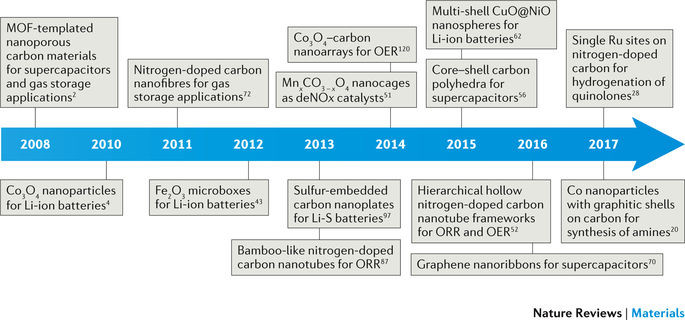金属有機構造体由来のナノ材料
Nanomaterials derived from metal–organic frameworks
2017年12月5日 Nature Reviews Materials 3 : 17075 doi: 10.1038/natrevmats.2017.75

金属有機構造体(MOF)の熱的変換によって、カーボン系材料、金属酸化物、金属カルコゲナイド、金属リン化物、金属炭化物など、さまざまなナノ構造材料が生成する。こうしたMOF誘導体は、表面積が大きい、常にナノ細孔が存在する、機能調節が可能といった特徴を有し、このためセンシング、ガス貯蔵、触媒反応、エネルギー関連用途において良好な性能が実現可能になる。MOF由来構造体のナノメートルスケールの形態調節に進歩が見られたが、形態と性能の関係に関する知識をさらに深めることが依然として重要である。本Reviewでは、得られたナノ材料のサイズ、形態、組成、構造の制御を可能にする合成戦略と最適化された方法をまとめている。加えて、MOFを鋳型として用いるなどの合成方法で作製した材料の性能を比較している。我々の目標は、MOF由来ナノ構造体の形態と物理化学的特性の関係を明らかにして、センシング、触媒反応、エネルギー貯蔵・変換といった用途向けの性能を最適化することである。
Corresponding Author
The thermal transformation of metal–organic frameworks (MOFs) generates a variety of nanostructured materials, including carbon-based materials, metal oxides, metal chalcogenides, metal phosphides and metal carbides. These derivatives of MOFs have characteristics such as high surface areas, permanent porosities and controllable functionalities that enable their good performance in sensing, gas storage, catalysis and energy-related applications. Although progress has been made to tune the morphologies of MOF-derived structures at the nanometre scale, it remains crucial to further our knowledge of the relationship between morphology and performance. In this Review, we summarize the synthetic strategies and optimized methods that enable control over the size, morphology, composition and structure of the derived nanomaterials. In addition, we compare the performance of materials prepared by the MOF-templated strategy and other synthetic methods. Our aim is to reveal the relationship between the morphology and the physico-chemical properties of MOF-derived nanostructures to optimize their performance for applications such as sensing, catalysis, and energy storage and conversion.

